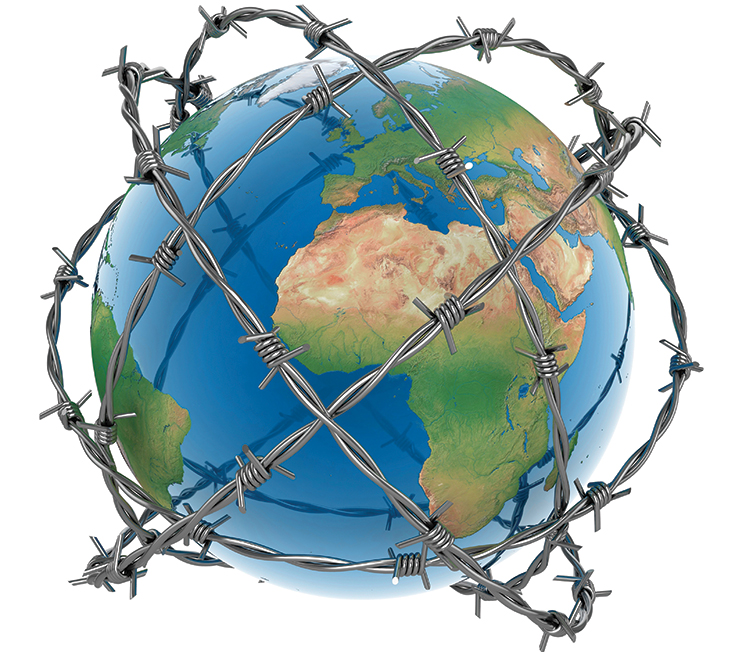The twelve key climate risks to international security
Security experts have identified 12 key climatic risks to international security that may shape the geostrategic landscape of the 21st century. These risks are explored in a multi-author volume by the Center for Climate and Security and partners called Epicenters of Climate and Security: The New Geostrategic Landscape of the Anthropocene, released at the Fourth Annual Deserts Conference at Oxford University.

Climate change acts as a threat multiplier within the geostrategic environment – see CRJ 12:4 (image: Milosh Kojadinovich/123rf)
In the wake of extraordinary upheaval in the international effort to address climate change, the report presents a compelling case for why tackling these climate and security ‘epicentres’ – major categories of climate-driven risks to international security – should be a top priority for governments and institutions around the world.
“Any one of the climate and security epicentres can be disruptive,” said Caitlin Werrell, Co-President of the Center for Climate and Security and editor of the report. “Taken together, however, these epicentres can present a serious challenge to international security as we understand it.”
The report includes analysis of 12 significant climate and security epicentres, which were selected owing to their nature as risks to critical parts of the international nation-state system (food, water, trade, health, cities, sovereignty) that can ripple out into serious global security crises, especially if they occur in tandem.
The epicentres span the globe, and many are fundamentally interconnected. These epicentres already exist, and all are likely to continue to intensify in the absence of adequate ameliorative solutions. They include the following, covered by authors with a broad range of expertise:
-
Eroding State Sovereignty: An inability to absorb the stresses of a rapidly-changing climate may erode state sovereignty (Francesco Femia and Caitlin Werrell);
-
Disappearing Nations: Many low-lying nations are in danger of being completely submerged by rising seas (Andrew Holland and Esther Babson);
-
Conflict Over Melting Water Towers: Climate change can increase tensions and conflict among the four billion people dependent on mountain ‘water towers’ (Troy Sternberg);
-
Conflict Over Fisheries: A warming ocean is driving critical fish stocks into contested waters, contributing to conflict between states (Michael Thomas);
-
Tensions in a Melting Arctic: Increased activity in a melting Arctic raises new security and geopolitical risks (Katarzyna Zysk and David Titley);
-
Weaponised Water: As climate change exacerbates water stress, non-state actors, including international terrorist organisations, are increasingly using water as a weapon (Marcus King and Julia Burnell);
-
Disrupted Strategic Trade Routes: Climate change will place strains on maritime straits that are critical for global trade and security (Adam H. Goldstein and Constantine Samaras);
-
Compromised Coffee Trade: Climate change may also disrupt critical global trading networks, like the coffee trade, which currently supports 125 million people worldwide (Shiloh Fetzek);
-
More (and Worse) Pandemics: Climate change may increase the likelihood and range of pandemics, which could threaten global security (Kaleem Hawa);
-
Flooded Coastal Megacities: Rapidly expanding coastal megacities are threatened by climate impacts like sea level rise, which can destabilize nations (Janani Vivekenanda and Neil Bhatiya);
-
Increased Displacement and Migration: Climate change is becoming a more significant driver of migration and displacement (Robert McLeman);
-
Enhanced Nuclear Risks: Climate change, nuclear security, and policies that are not sensitive to both simultaneously, can increase regional and global security threats (Christine Parthemore).
The rapid rate of climate change means that understanding and getting ahead of these risks is critical. The report and the Oxford conference explore the tools and practises necessary to tackle these epicentres of climate and security, emphasising preventive modes of governance that will require new and more versatile ways of anticipating, managing, mitigating and eliminating these risks, from the local to the global scale.
“This report demonstrates the kind of cross-sectorial thinking needed to anticipate and mitigate climate-related systemic risks – risks that will be disruptive at local, national, regional and global levels,” said Francesco Femia, Co-President of the Center for Climate and Security and editor of the report. “Security risks thousands of miles away can have an effect on us at home. Understanding that can help advance preventive rather than reactive solutions.”
The report is published by the Center for Climate and Security in partnership with The American Security Project, Carnegie Mellon University, The Planetary Security Initiative, the Skoll Global Threats Fund, and the Oxford University School of Geography and Environment.
Read more in CRJ 12:4, where Caitlin E Werrell and Francesco Femia highlight just how seriously the threat that climate change poses to national security communities is being taken, given that it acts as a threat multiplier within the geostrategic environment